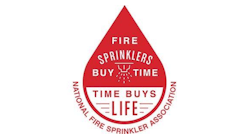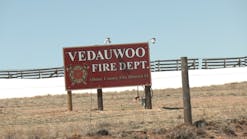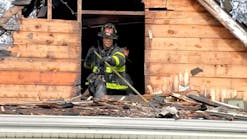Understanding Residential Sprinkler Systems and Related Codes
You have heard the benefits of residential sprinkler systems and this article is intended to give some brief facts about the installation of residential sprinkler systems. One of the biggest myths about sprinkler systems is the water damage that ensues after all of your sprinklers go off in the house.
The media has done a wonderful job in providing false information on sprinkler systems. Think of the various commercials or movies in which one sprinkler is operated and all the sprinklers in the building soon operate as well. This is incorrect and many times this public opinion on sprinklers happens. Sprinklers operate when exposed to the determined heat level of a fire and only the sprinklers exposed to heat operate.
What makes it a residential fire sprinkler system? The fire service over the years has prompted their communities to adopt fire sprinkler requirements in residential settings. The International Fire Code 2006 edition requires sprinklers in all residential occupancies.
Now don't get too excited yet, this does not include "R-2" occupancies which are those occupancies covered by the International Residential Code. The residential code is responsible for the construction of one- and two-family dwellings and certain condominiums or townhouses. The installation of automatic sprinklers in these occupancies is limited to community ordinances that require these homes be equipped with a system or an agreement with developers to install sprinklers.
The National Fallen Firefighters and the 16 Life Safety Initiatives include supporting residential sprinkler initiatives. I have found that the fire service supports residential sprinklers in a public setting, although a complete understanding of the system is limited. So let's take a look at some of the requirements of a residential sprinkler system.
Requirements for Installation
Automatic sprinkler systems are designed and installed per standards which are developed by the National Fire Protection Association (NFPA). These standards are developed through a process and are typically referred to by an adopted building or fire code. NFPA 13, the Standard for the Installation of Sprinkler Systems, which is the referenced standard for the installation of most commercial sprinkler systems. In the residential setting there are two standards that systems may be designed for. NFPA 13D, Standard for the Installation of Sprinkler Systems in One- and Two-Family Dwellings and Manufactured Homes or NFPA 13R Standard for the Installation of Sprinkler Systems in Residential Occupancies up to and Including Four Stories in Height. These standards are the basis for the design and proper installation of the sprinkler system.
Sprinklers installed in homes are slightly different then those installed in commercial occupancies. If we start at the supply of the sprinkler system many residential sprinkler systems are supplied by common fire protection and domestic water supply.
In areas where a municipal water system is installed, the water line to the home will be sized to accommodate the sprinkler system demand and the domestic water demand. In areas without municipal water the well will need to be sized in accordance with NFPA 13D and may require a small tank or pump to be installed. This is one area where commercial sprinkler systems and residential sprinkler systems vary. The design of the system. The design in a commercial setting is commonly designed on an area/density method. The application of water over a certain area is the basis for the design. In a residential setting of a one- or two-family dwelling, only two sprinklers are calculated for the needed flow. The number of sprinklers calculated is based on previous fire history, testing of sprinklers, and the successes that residential sprinklers have.
If we do the math the minimum gallons per minute (gpm) of a sprinkler is 13 gpm in a two-sprinkler calculation. Calculations are utilized to ensure the proper pressure and gpm is found at the most remote (typically farthest away from the riser assembly) sprinklers. So a typical system would require 26 to 50 gpm for the system design. In areas without municipal water supply a small indoor tank can be utilized and provide the needed fire flow for the calculations for 10 minutes (some cases allow the use of seven minutes).
Commissioning Process for Residential Sprinkler Systems
Sprinkler system components are specifically tested and labeled by Underwriters Laboratory or Factory Mutual for meeting the necessary standards and installation in residential occupancies. The systems require a visible inspection of the sprinkler piping and must include no visible leakage under normal operating conditions. In a commercial occupancy the sprinklers systems are tested at 200 psi for two hours.
Sprinklers installed in residential occupancies can also be of the concealed type. The sprinkler is located behind a small plate which releases at a lower temperature then the activation of the sprinkler. This plate is used to hide the sprinkler and have it blend into the features of the house. Remember that these plates can not be painted or caulked.
The goal of residential sprinkler systems is life safety. They are designed to keep a typical residential fire in "check" so the occupants can safely escape from the building. Many times you hear about the water damage that occurs due to the operation of a sprinkler during a fire situation. This is a great change to provide some simple education and compare the water damage to fire damage. Typically water damaged contents can be dried out and salvaged by a clean up company. During a fire situation this is typically very limited. Additional information on proper design, installation, and maintenance of residential sprinkler systems (one- and two-family residences) can be found in NFPA 13D or visit some of the links below for additional information.
Related Links:
- National Fire Protection Association website
- Underwriters Laboratories Residential Sprinklers webpage
- Phoenix Fire Department's Home Safety: Residential Sprinklers webpage
- U.S. Fire Administration's Residential Sprinkler Systems webpage
- U.S. Fire Administration's New Home Construction and Life Safety publication
- Fire Team USA website
- Home Fire Sprinkler Coalition website
- National Fire Sprinklers Association's Homeowners Guide to Fire Sprinkler Systems






